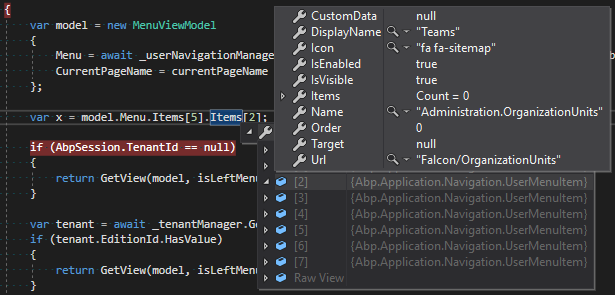Hi @alper,
Thank you for your responce. I am definately logged into the application when trying to revcieve the auth token, but the abp.auth.getToken() method still returns null, and the "Abp.AuthToken" cookie does not appear to be present in the browser.
Do you know what might cause the cookie to not be set and available like this? Are there parts of the application where behaviour like this could inadvertently be configured?
Thanks,
David
When we swap the slots, the domain names don't change - the clients using the production site/domain would still be using the same site/domain after we swap, it's just that the code in that environment has changed. So a cookie for domain xyz should still be valid.
We strongly believe that it is server-side session invalidation that causes the users to be logged out and forced to log in again, and that is what we are trying to find a solution for.
Hi @Maliming
I donwloaded a fresh demo project and the menu items show and hide as expected, with their display being governed by both feature dependancy and permission dependancy.
Clearly there is an issue with my project. Would you have any suggestions/ideas as to where or what the issue might be, as to why my menu items are not showing/hiding correctly?
I've defined the features in AppFeatureProvider.cs and defined the constants in AppFeatures.cs. I've then assigned features to editions and places the featureDependancy checks on the menu items. Have I missed a step?
Hi @Ryancyq, Yes that's correct - it's a tenant admin with all permissions but the tenant lacks the feature, and thus, the admin user not should be able to see or interact with it.
I tried swapping the order of the permissionDependancy and the featureDependancy, just incase their defined order in the Navigation provider affected the outcome of the FillUserMenuItems method, but to no avail.

I also implemented the feature checker, which does return false on the tenant admin having the feature, but the menu item still displays.

Hi @Ryancyq - the GetMenuAsync method seems to be returning all of the menu items relevant to a tenant (i.e. it doesn't contain the host dashboard), but this also means its returning the items that should be hidden. The tenant user is an admin, and from a permissions viewpoint, has permission to view those menu items, but the items should be hidden due to the tenant features.

Sorry guys, I should've led with the product details. We're using .Net Core MVC v6.9.1.
@Ryancyq - if I'm not mistaken, the above link is for an Angular solution - is there a similar method that needs to be implemented for the MVC product?
We don't have the time or resources to set up another server instance to test for the issue in a fresh download, but what we could do it create an account on one of our environments for you, so that you're able to investigate?
Yes - the issue has been encountered on three different client machines.
Hi Aaron,
It can be as little as two/three tabs, and more easily produced with more tabs than that.
@ismcsgdas no I haven't - the behaviour isn't consistent, and isn't handled gracefully one way or another (either crashing completely as a 500 error or as the 401 that breaks the BlockUI and provides no details)